2008 Mazda MX-5 – Click above for high-res image gallery
Just as it appeared that winter was finally drawing to close here in Michigan, one of the definitive summertime cars turned up on our doorstep -- the Mazda MX-5 Miata . Somewhere back in the middle part of the last century, small, lightweight, roadsters flourished with a variety of models available from mostly British manufacturers. Names like MG, Triumph, Austin-Healey and Lotus defined the genre. Unfortunately, a number of factors such as random intermittent windshield wipers, intermittent headlights, intermittent ignition, persistent oil leaks and predisposition for the bodies to convert to iron oxide soured the reputation of these and other car builders. This was followed by the consolidation of the most of the British car industry into British Leyland and then the onset of safety and emissions regulations. By 1980, the classic British sports car had become all but extinct.
Then a strange thing happened. Mazda, always had a reputation as being slightly offbeat (witness its dedication to the Wankel rotary, which exists to this day) introduced a new model dubbed the MX-5 Miata . This compact, rear-drive two-seat roadster bore a strong resemblance to a '60s vintage Lotus Elan. However, unlike the Elan and its compatriots, the Miata started every time you turned the key, didn't leave you drenched when it rained, and didn't leave puddles of oil on your garage floor. In other words, it was a classic British sports car that worked like a modern Japanese car. Read on after the jump to find out how the latest incarnation fares.
Photos Copyright ©2008 Brad Wood / Damon Lavrinc / Weblogs, Inc.
The current third-generation Miata still carries the same basic proportions of an Elan or MGB, but with styling updates to reflect a little of the current Mazda design language. This is most obvious in the wheel well shape. Overall, the Mazda still has a clean, basic profile with no major flourishes -- just smooth bodywork with the long hood/cab rearward sports car look. Like the second gen-model, this one has fixed headlights while the oval shaped air intake has been restored from the original car.
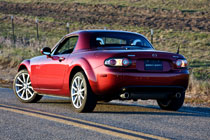
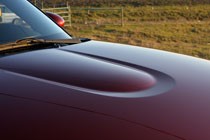
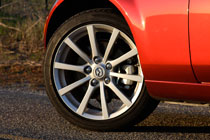
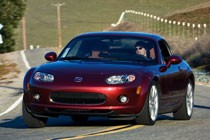
The entry model still has the same top mechanism that appeared on the 1989 original and there's absolutely no reason to ever change it. One lesson that General Motors must learn when they rework the Solstice and Sky is that simple tops work best on roadsters. In fact, designers should not try to improve on the Miata top -- just copy it. Back in 1990 when I was graduating from college and looking to buy a new car, it came down to the Miata or a Mustang LX 5.0. The 'Stang's torque and back seat ultimately won my dollars, but I've always loved the Miata. When I test drove one, the first thing I did was lower the top. It's easy: reach above the mirror, release the latch, and drop it over your shoulder. Five seconds and it was done. Raindrops falling? Reach over the shoulder, pull up and latch. No muss, no fuss, and no need to get out, or even unbuckle the seat belt. Absolutely perfect.
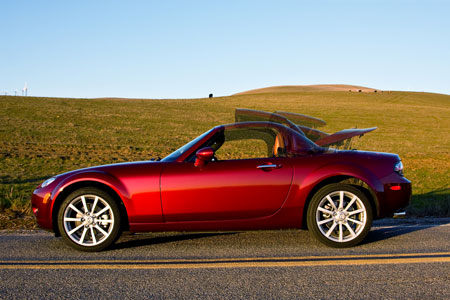
For 2007, Mazda messed with the formula for the first time in nearly two decades. The original soft-top is still there of course, but Mazda added the option of a retractable hard top. Normally, I consider these to be a nightmare. First off all, no car with a back seat should ever have a retractable hard top, because they just make the proportions look horrible. The only hardtops that look good are on two-seaters like the Mercedes-Benz SL and SLK. They also add a lot of weight and complexity to the car. Having made my opinion on retractable hard tops clear, I must say that the one in the Miata is actually pretty good. The classic proportions of the car remain unchanged. In fact, almost nothing about the car is altered except for the added switches at the top of the center stack to raise and lower the top.
In closed configuration, the Miata looks almost exactly like a standard model with the optional removable hard top that has been available since almost the beginning. In open form, it's indistinguishable from the soft-top version. After starting the engine, you still have to manually release the latch at the windshield header and then hold the switch for about 20 seconds as the tonneau lifts, the top retracts and then the tonneau drops back down. While that happens the windows drop a couple of inches then go back up when the operation is complete. No hassle, but if you have to manually release the latch, why not just flip the whole thing over your shoulder anyway. When the clouds arrive, you have to stop and reverse the process, latching the top to finish.
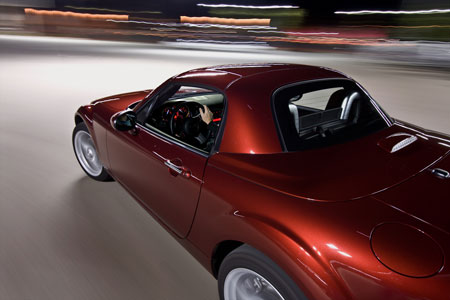
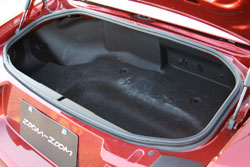
As soon as the MX-5 arrived, I immediately hopped in, dropped the top and headed out for lunch. As it happened, I had not actually had the opportunity to drive a Miata since that first test drive nearly 18 years earlier. All the old memories came rushing back as I drove away from the garage by my office and hit a few curves on the way home to pick up my wife. For anyone who enjoys top down motoring in a relatively light (by modern standards) tossable car, this is the machine for you. Those of you familiar with the afurementioned British classics know that you don't need huge amounts of power to have fun in the right car. Those of you familiar with me will know my philosophy that there is no such thing as too much torque. In spite of that preference, I'm willing to sacrifice some twist for a car like this.
When I first visited England in the early '90s, I immediately understood why British carmakers made those light nimble sports cars. On the rural B roads, straights are rare and roads are built around the trees instead of the other way around. In these conditions you don't need a lot of power, just the ability to carry momentum from one corner to the next. The Miata is just such a momentum racer. Its 2.0L twin-cam four cylinder is naturally aspirated and loves to rev. It's not in the same ballpark as the Honda S2000, but the 166hp peak comes at 6,700rpm and the mere 140lb-ft of torque peaks at 5,000rpm.
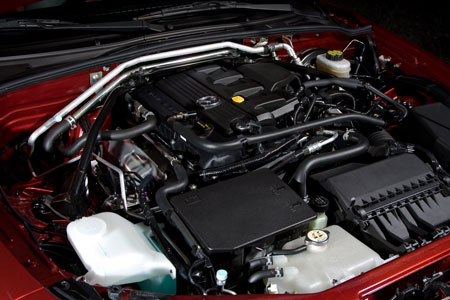
Fortunately, the wonderful 6-speed manual that sits behind the engine makes it easy to extract the most of what is available from the engine. The stubby shift lever pops up out of the console in exactly the right position. Little effort is required to move between gears and the direct linkage is amazingly precise. Perhaps the next-gen Miata will adopt the turbocharging and direct injection technology from the MazdaSpeed 3 and 6. A 1.4L four with GTDI will put out similar peak power (witness VW's 170hp 1.4L TSI engines) with a much fatter torque curve.
Fortunately the late snowfall that arrived the evening after the car was delivered didn't stick around for long, but while it was around, the snow tires that were still mounted on the car cooperated beautifully with the stability control that was part of the Grand Touring package. In hard top form with proper winter tires, this really is quite a capable all-weather car. (If you're wondering why the accompanying photos don't look much like Michigan, it's because Damon and Brad shot a similar car in their native habitat of Northern California.)
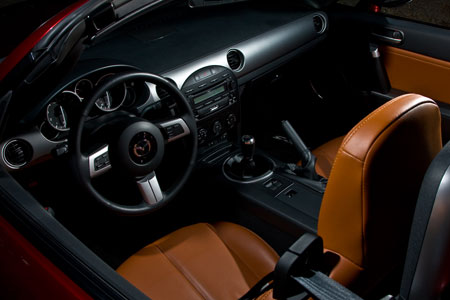
When temps warmed up later in the week, the top was banished at every available opportunity. With the thermally-enhanced seats switched on (try that in a Lotus with Lucas electrics), the heater running and the windows up, open-air motoring remained comfortable even with ambient temps in the upper thirties. Like its British ancestors, the Miata is a snug fit and won't be comfortable for those of broader lateral dimensions. The gauges are clear and legible and the seats are comfortable and supportive.
Limited torque means the Miata doesn't leap off the line, but its solid structure allows the suspension to make the best use of the tires. The Miata's ride is pretty firm and its P205/45ZR17 tires don't leave much sidewall to provide extra compliance. The upside is a very direct connection between the driver and the road. If the gap between your home and workplace includes pavement that seems to have been laid out without any thought of getting there in the least possible distance then you're in for some fun. The Miata is like a go-kart for the street, and it's even kind of practical. The trunk is only 5.3 cu.ft but it's usefully shaped to hold a few bags a groceries or enough stuff for a weekend getaway.
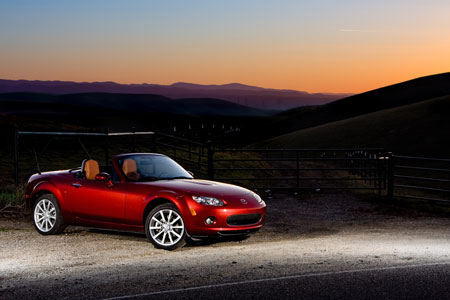
For drivers who don't necessarily favor the flashy looks of the similarly-priced Solstice or Sky, the Miata is a great alternative. It doesn't currently offer a high-output powertrain to rival GM's 2.0L GTDI EcoTec, but the top, whether you opt for hard or soft varieties, is vastly superior to the contraption that GM offers. The base soft-top Miata starts at $20,858 while the Grand Touring hard top runs $26,760. Is the hard top worth $2K more than the flexible version? I guess that depends on wear you live and whether you have a garage. If you live in warmer climes where you're likely to keep the top down most of the time, probably not. If you live somewhere with winter weather and you plan to drive year-round, you might want to make the additional investment. On the other hand, the soft version is so unbelievably easy to put up and down, the hard top seems pretty superfluous. For my money, even in Michigan, I'd go fabric.
Photos Copyright ©2008 Brad Wood / Damon Lavrinc / Weblogs, Inc.
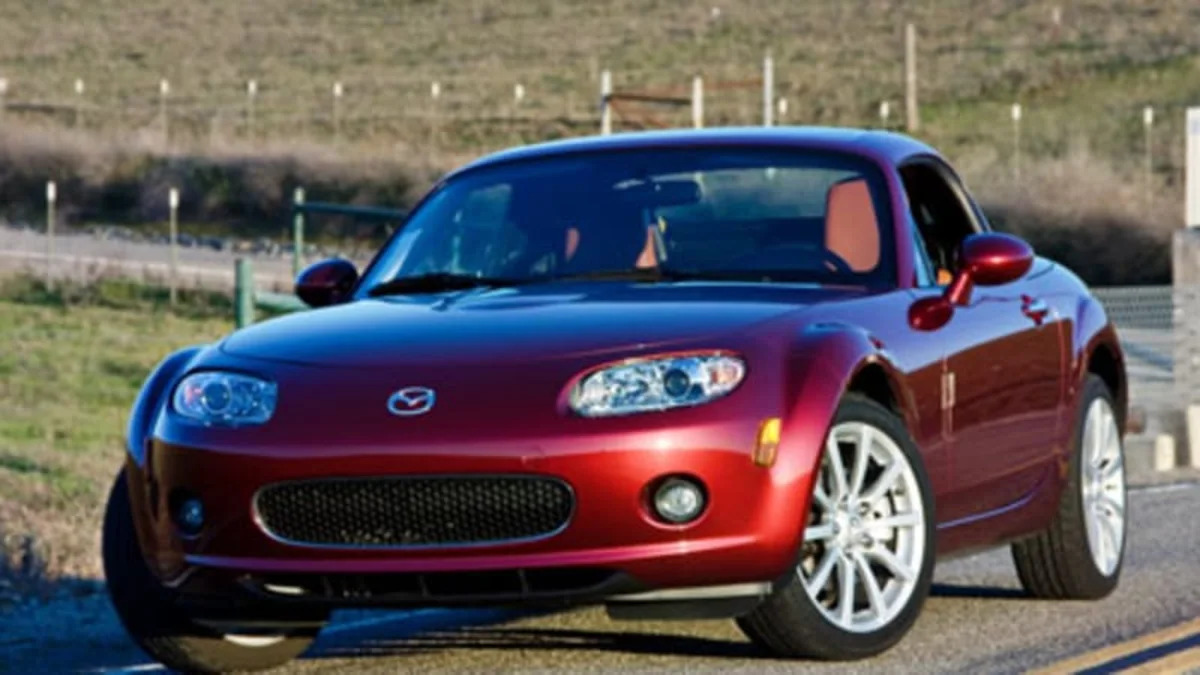
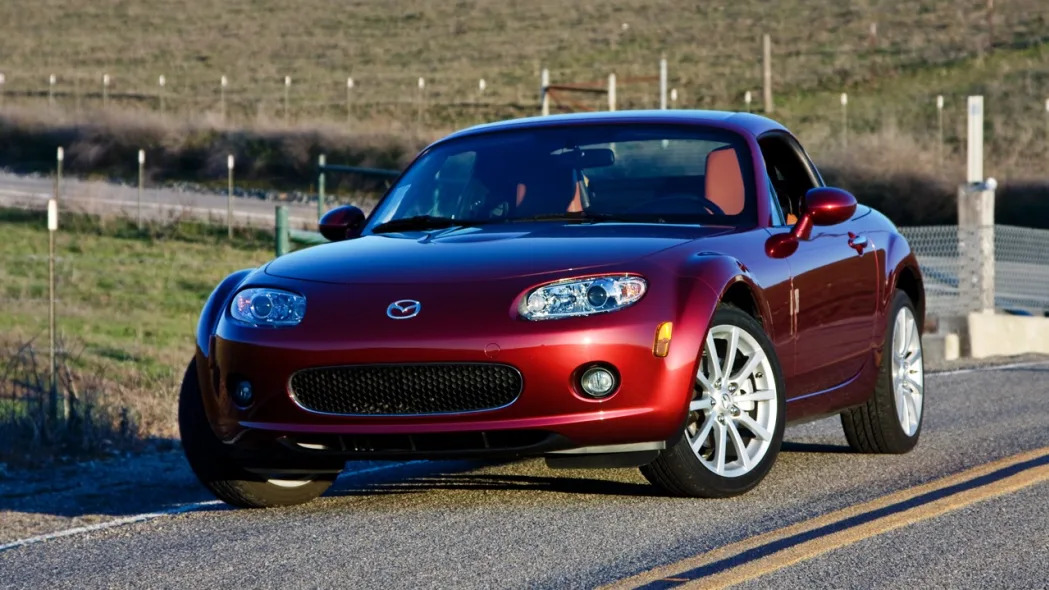

Sign in to post
Please sign in to leave a comment.
Continue